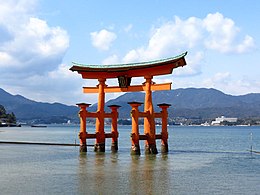
Back ضريح إيتسوكوشيما Arabic ضريح ايتس و كوشيما ARZ Santuariu Itsukushima AST İtsukuşima məbədi Azerbaijani Ицукусима ғибәҙәтханаһы Bashkir Kuil Itsukushima BAN Шинтоистко светилище на Ицукушима Bulgarian Santuari d'Itsukushima Catalan Svatyně Icukušima Czech Itsukushima-Schrein German
| UNESCO World Heritage Site | |||||
|---|---|---|---|---|---|
 The torii of Itsukushima Shrine, the site's most recognizable landmark, appears to float in the water. | |||||
| Location | Itsukushima, Japan | ||||
| Criteria | Cultural: i, ii, iv, vi | ||||
| Reference | 776 | ||||
| Inscription | 1996 (20th Session) | ||||
| Area | 431.2 ha | ||||
| Buffer zone | 2,634.3 ha | ||||
| Website | www | ||||
| Coordinates | 34°17′45″N 132°19′11″E / 34.29583°N 132.31972°E | ||||
| Japanese name | |||||
| Hiragana | いつくしまじんじゃ | ||||
| Kyūjitai | 嚴島神社 | ||||
| Shinjitai | 厳島神社 | ||||
| |||||
Itsukushima Shrine (厳島神社, Itsukushima-jinja) is a Shinto shrine on the island of Itsukushima (popularly known as Miyajima), best known for its "floating" torii.[1] It is in the city of Hatsukaichi, in Hiroshima Prefecture in Japan, accessible from the mainland by ferry at Miyajimaguchi Station. The shrine complex is listed as a UNESCO World Heritage Site, and the Japanese government has designated several buildings and possessions as National Treasures.[2]
The Itsukushima shrine is one of Japan's most popular tourist attractions. It is most famous for its dramatic gate, or torii on the outskirts of the shrine,[2] the sacred peaks of Mount Misen, extensive forests, and its ocean view.[1][3] The shrine complex itself consists of two main buildings: the Honsha shrine and the Sessha Marodo-jinja, as well as 17 other different buildings and structures that help to distinguish it.[3]
- ^ a b Nussbaum, Louis-Frédéric (2005). "Itsukushima-jinja" in Japan Encyclopedia, p. 407.
- ^ a b Cali, Joseph; Dougill, John; Ciotti, Geoff (2013). Shinto Shrines: A Guide to the Sacred Sites of Japan's Ancient Religion. University of Hawai'i Press. ISBN 9780824837136. JSTOR j.ctt6wqfhm.
- ^ a b "Ramsar and World Heritage Conventions: Converging towards success - Case study: Itsukushima Shinto Shrine, Japan" (PDF). Ramsar. 15 September 2017.
